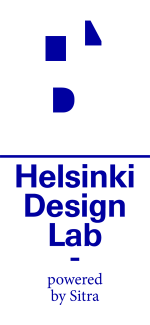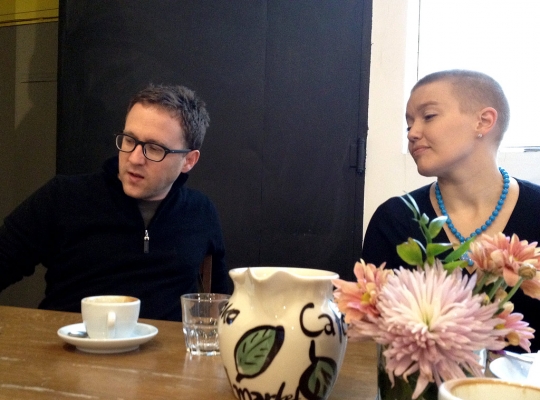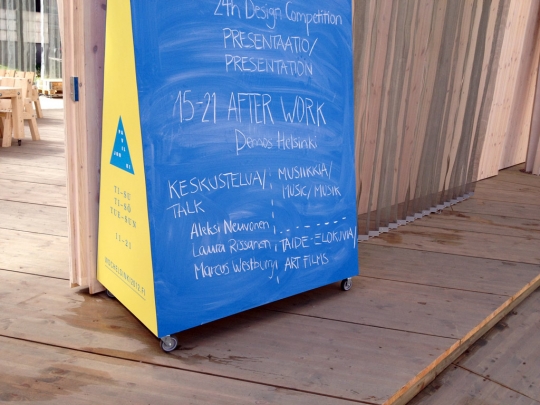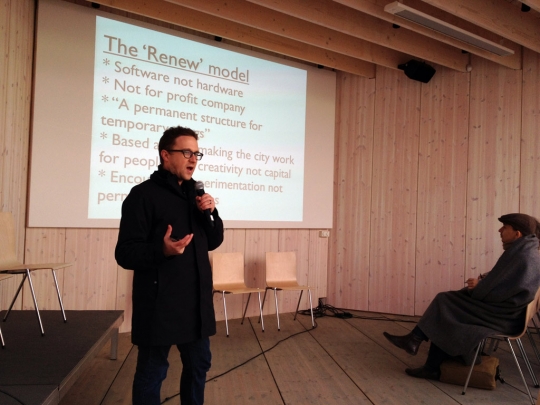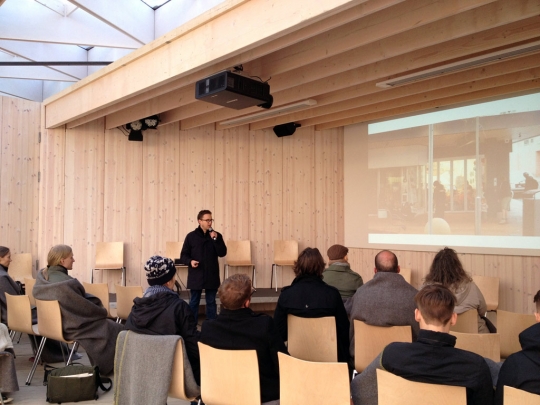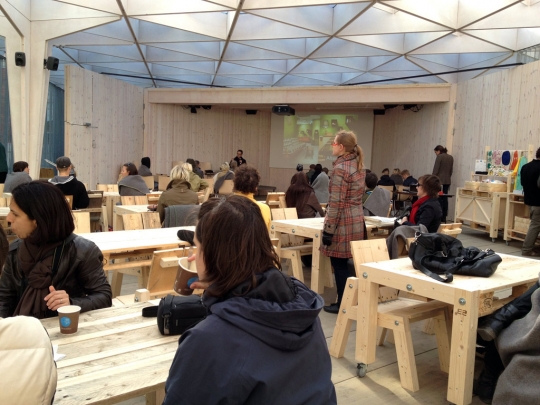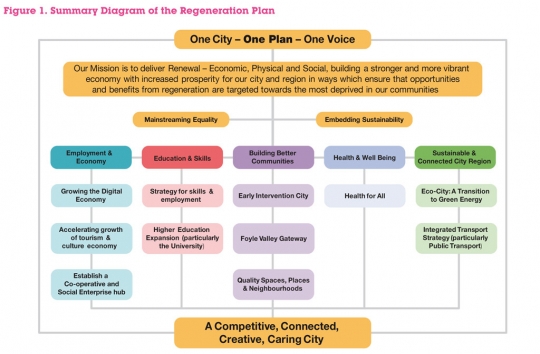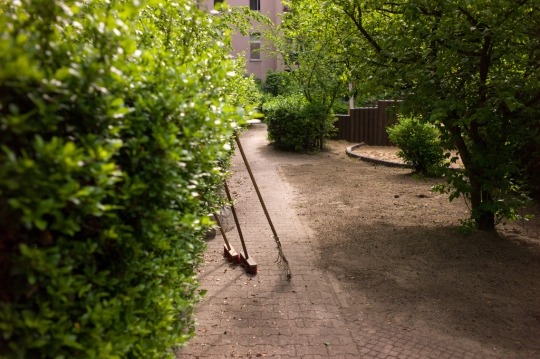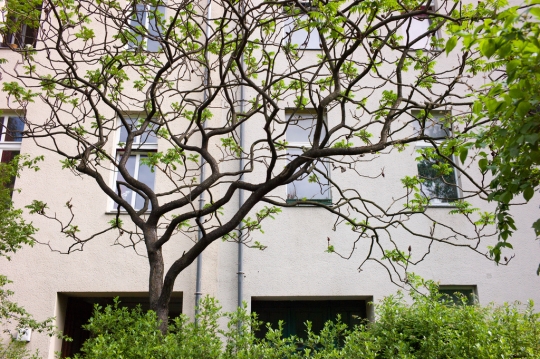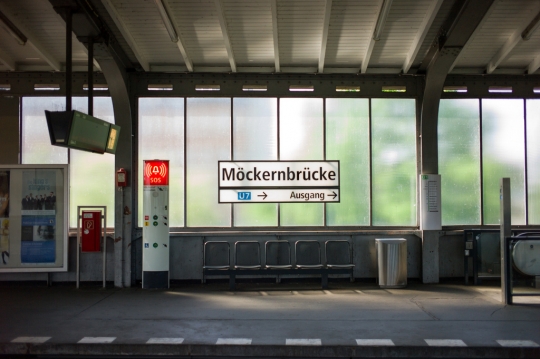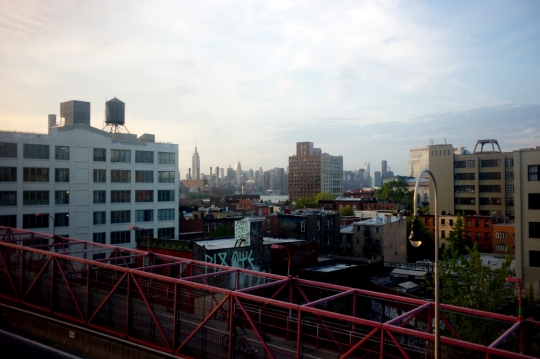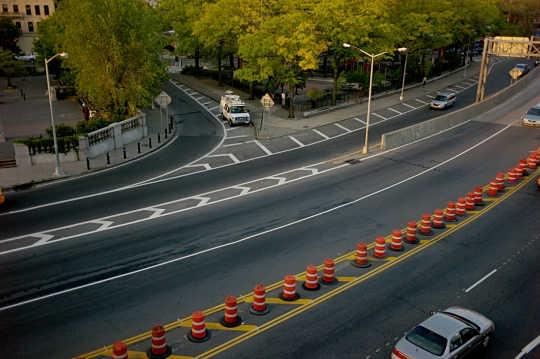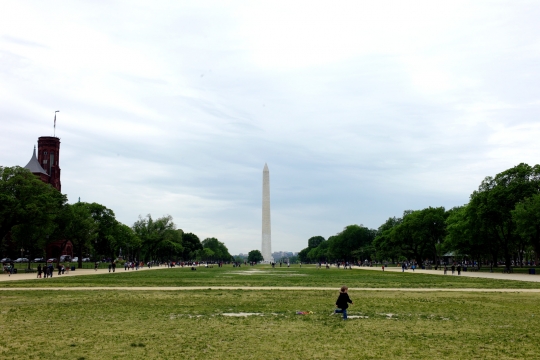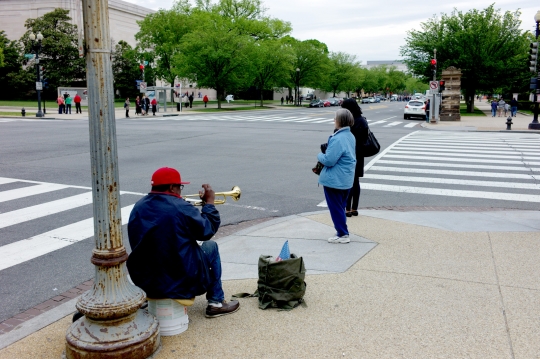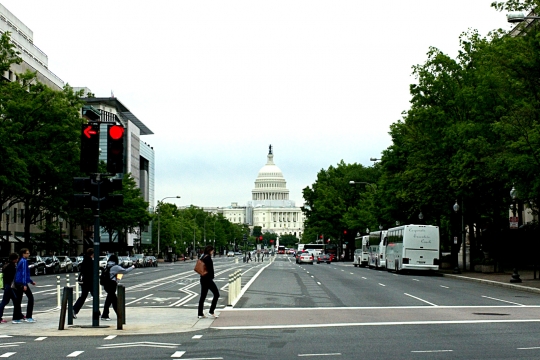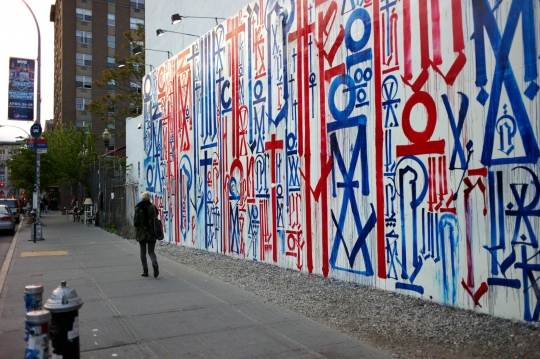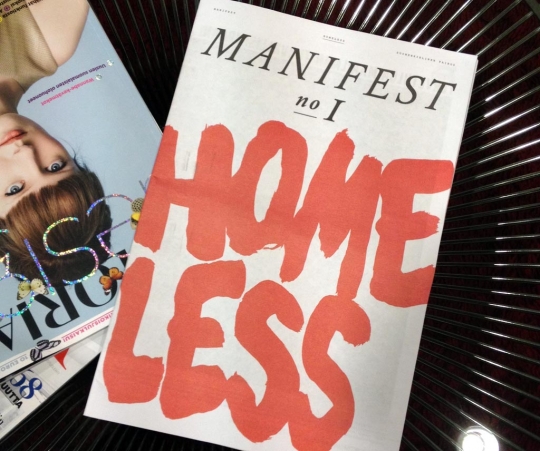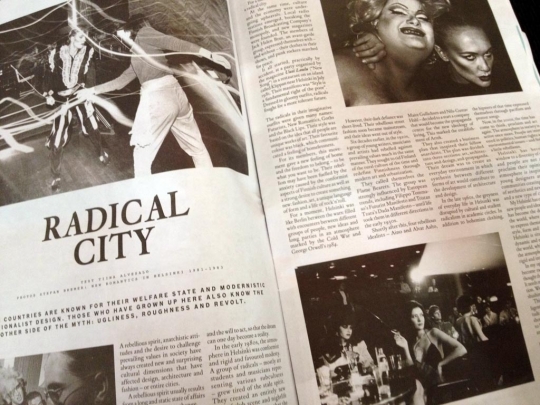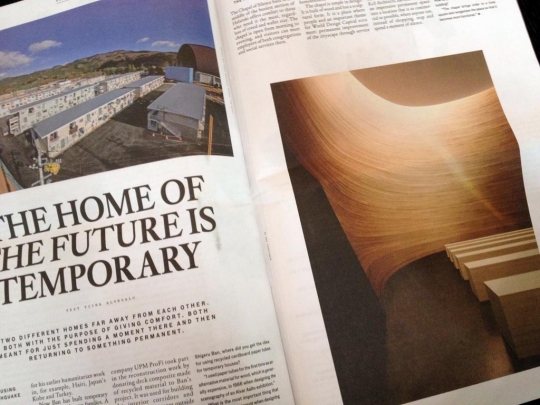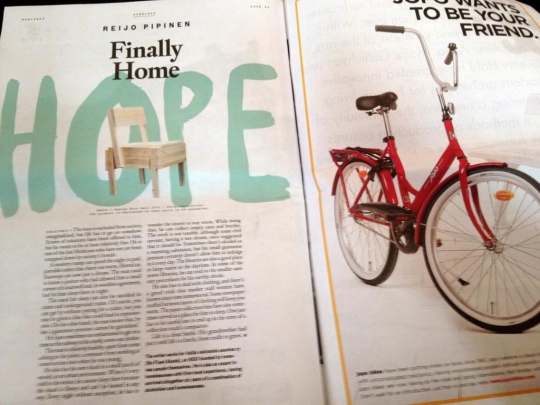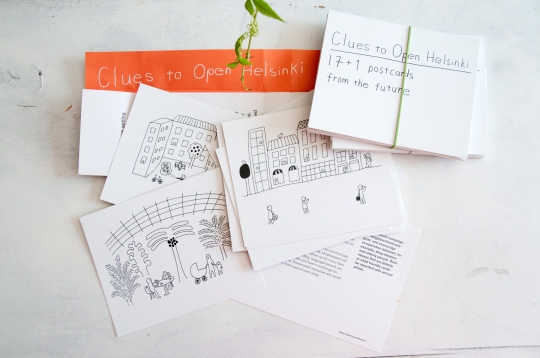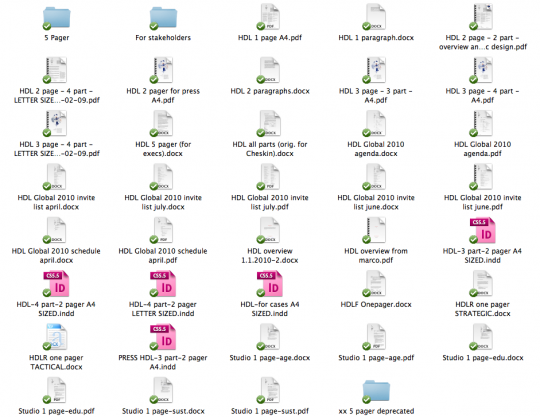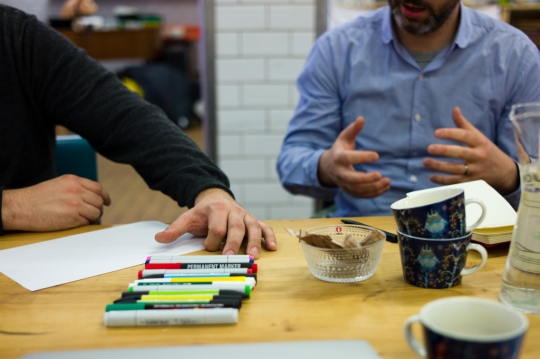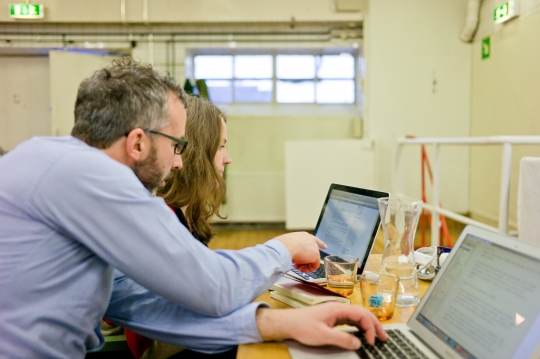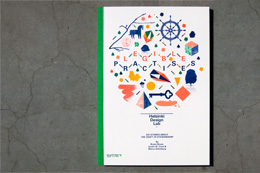Weeknotes
Hello, it's me again, and so predictably this is a few days late.
Before I run through last week's events, I thought I'd share this. Bryan tweeted a Dezeen article about the new Shard tower in London—an interview with the lead architect, Renzo Piano—noting in particular the usefully low car parking provision. There are 87 floors in The Shard, 72 of which are habitable, and it has 47 parking spaces, essentially to cover the requirements of disabled people, according to Piano.
Having worked on a few so-called sustainable developments in my time (admittedly mostly in car-dominated Australian cities) this is extraordinarily impressive. Piano also notes that the direction here came from Mayor Ken Livingstone, which is also impressive—politicians driving that number down is rare; usually they're in a defensive mode, worried about their constituents (often underestimating their constituents' own ability to change, actually) and pushing back against the design teams.
Here in Helsinki, every day we look out onto Jätkäsaari, which is one of the city's strategic sites for sustainable development. A typical block there will be designed to have around 7 floors and have to make space for approximately 120 parking spaces. Both cities are well-served by public transport (in fact, Helsinki has previously been voted as having the best public transport in Europe) and Helsinki being a compact city, you could walk to most bits of central Helsinki from Jätkäsaari. This quite different parking ratio here is also directed by the city council, of course.
This disparity seemed so ludicrous I had to draw it. First, the two developments: The Shard at 87 floors, and 47 parking spaces; a new "sustainable" development in Helsinki's Jätkäsaari has 7 floors, and 120 parking spaces:

Parking spaces for The Shard tower, London versus parking spaces for Jätkäsaari sustainable development, Helsinki.
To put it another way, the ratio for The Shard is around 0.5 parking spaces per floor, whereas Jätkäsaari's ratio is around 17 spaces per floor. What if you applied the ratio for The Shard to Jätkäsaari and vice versa?
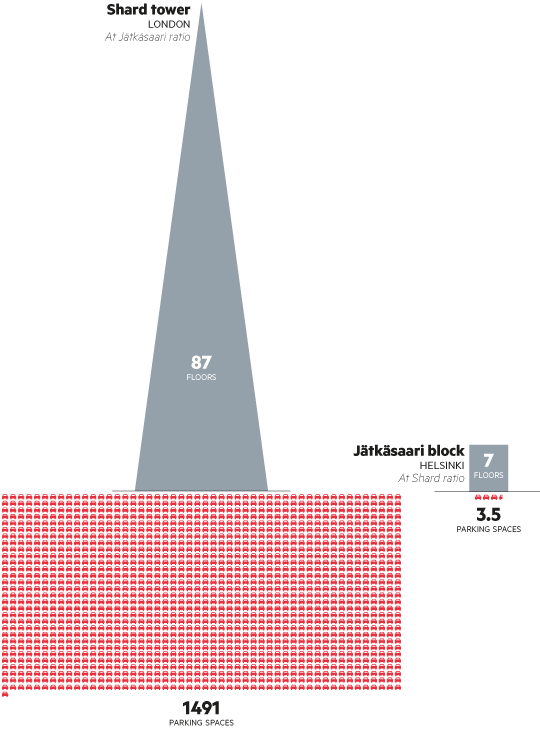
Parking ratio for Jätkäsaari block applied to Shard tower, and vice versa
Thought for the day.
Anyway, last week's thoughts had a big public holiday-shaped hole in them on Thursday, but the rest of the week was full of life.
I was knee-deep in designing Brickstarter mock-ups—more on that soon, but some old sketches are now up at brickstarter.org—and working with the Sitra management team on our new working patterns, workspaces and so on. Kalle was researching street food legislation in global cities, roaming (via the web) from Portland to Stockholm.
Meetings-wise, I had time for a poor cup of coffee but a good chat with Melinda Sipos, a Hungarian designer/artist whose provenance includes the seemingly excellent Kitchen Budapest. I met up with web developer Ville Kolehmaimen from Fusion Inc, had lunch with our own Pekka Salmi to discuss what we (Sitra) might research around crowdfunding legislation in Finland, and Kali Auvinen and I had a fascinating Brickstarter-related conversation RE NIMBYism and sustainable development with the chairman of the Finnish wind power association.
Meanwhile, Bryan was in the USA for an equally full week, culminating with a panel at the inspiring Studio-X NYC (run by our chums Geoff Manaugh and Nicola Twilley) which centred around the future of design practice in a plural, political world. He also was part of a panel at WantedDesign about the possibility of entrepreneurial design to sketch out new cultural possibilities, including +Pool, Brickstarter, and games that reveal the richness of the spectrum of possible social interactions. In between he was meeting and on the phone to line things up for HDL 2012.
Working across the Helsinki-Boston axis, Marco and Justin were embroiled in the usual intense stewardship required by our Low2No project.
Meanwhile, back in Helsinki, by the end of the week we were privileged to have Marcus Westbury of Renew Newcastle/Renew Newcastle fame in town. Marcus is an old colleague and friend from Australia, and we took advantage of him visiting London to bring him across to Helsinki for a couple of talks, as part of our Brickstarter research (for more on Marcus's work in this context, read the notes from this discussion we had a few months back, or this old post on "emergent urbanism" from my blog a few years ago.)
As those notes describe the general area I won't go into the ideas again here, suffice to say Marcus did a great talk for Sitra colleagues over lunch ...
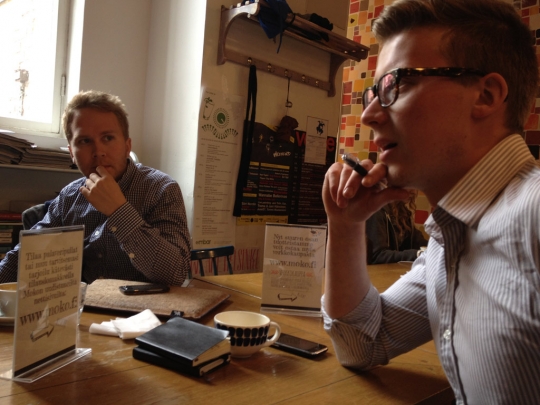
Kalle asks a question while Kalle looks on
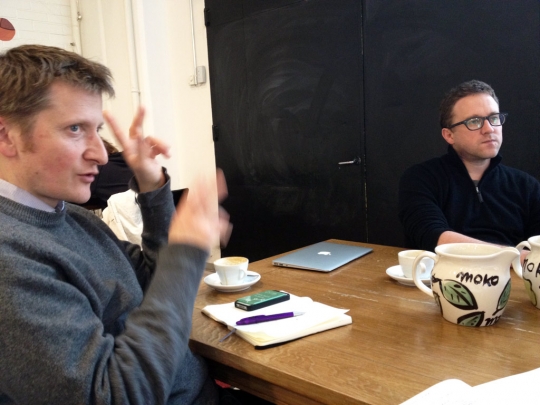
Marco reveals his Italian heritage
... And then Marcus repeated the feat for a public audience at a Demos Helsinki-curated "City 2.0" event at the World Design Capital Pavilion on Friday night.
Although it was so chilly that the pavilion felt like a wooden memorial to optimism, we had a good crowd of 40 to 50 or so (thanks!) and a good discussion after too.
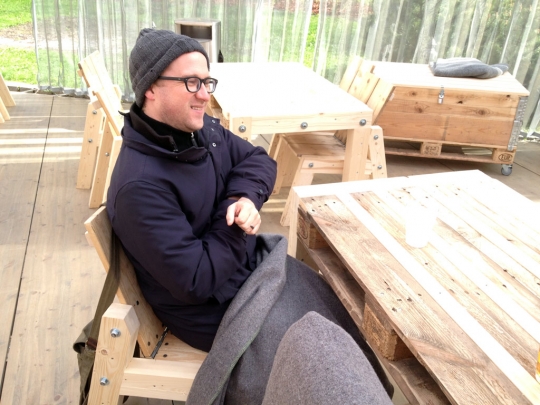
An Australian suffering the Helsinki spring.

Finns suffering the Helsinki spring.

Marcus's talk generated a good Q+A, including discussion of similar projects here in Helsinki.
Thanks to Marcus for coming over, and sharing his numerous insights, and thanks also to Tommi and the Demos crew.
Fortuitously, the following Saturday was Ravintolapäivä, Helsinki's festival of pop-up restaurants, and so I was able to walk Marcus around that too. This was in no way a hardship—it was the city at its best—and easy on the stomach too. Ravintolapäivä demonstrates a different kind of urban activism to Renew, but they're derived from similar instincts: creating a framework for encouraging everyday experimentation within the city. Saturday also demonstrated to Marcus that spring in Helsinki can be warm.
I've written all that up over at City of Sound, so do have a read over there if you want to learn more about the wondrous event that is Ravintolapäivä aka Restaurant Day, and what it might mean for cities like Helsinki. While you're there, note the use of Kalle's coffee stall as a honey-pot for design research—more on that soon from Kalle.
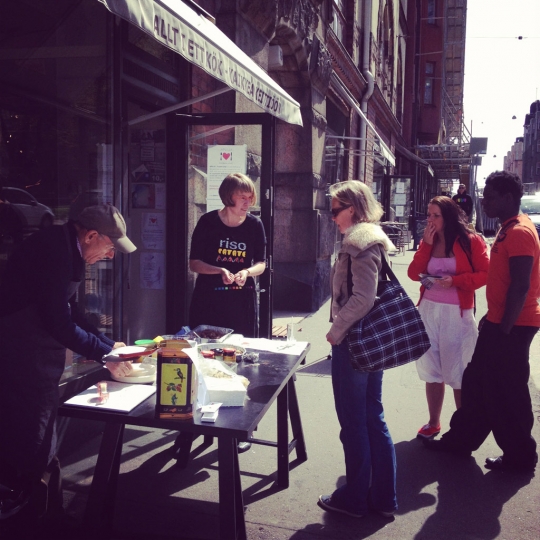
Ravintolapäivä is wonderful. Here, gourmet Italian food on the street.
OK, latenote for last week. The highlight was perhaps a great conversation with various representatives of Canada's Social Innovation Generation partnership (SIG), who were in the neighbourhood (well, Stockholm) and were kind enough to swing by Helsinki for a chat.
They're doing really interesting work scoping out what they call the "change lab" model, preparing the ground in Canada. We were visited by Cheryl Rose (Associate Director of Waterloo Institute for Social Resilence and Director, Program Development for SIG), Tim Brodhead, (JW McConnel Family Foundation, SIG, MaRS Discovery District), and Sam Laban (Education Program Manager, SIG). We have lots of visitors to Sitra and HDL, and always enjoy and learn from the discussions and connections, but rarely has a group been so well-prepared and asked such perceptive and insightful questions.
I'm intrigued by Canada, having never been but idly marking it as a kind of mirror/inverse of Australia (vast, sparsely-populated, resource-rich, echoes of empire, Anglo in bits, fine cities, incredible landscape, great cities etc. etc.—and it is of course completely different, I'm sure). And we've been delighted to see the thinking emerging there—as noted previously, their summary of lab-like iniatives ("Labs: Designing the Future") is definitely worth a read—and so we're really pleased to open up this diaglogue. It looks like I'll be visiting Canada in return, this November, which I'll update you about nearer the time. Thanks to Cheryl, Tim and Sam for popping in.
Bryan had to rush off after lunch with the Canadians, heading over to Derry. After noting the preponderance of wind turbines in the Irish countryside ...
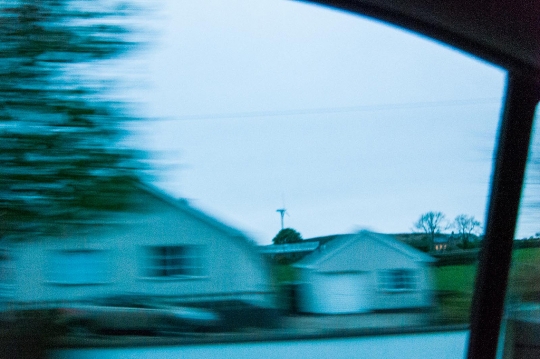
Turbines in the Irish countryside.
... he took part in the Academy of Urbanism's Annual Congress on The Resilient City, and he reports that It Was Good. The level of conversation was excellent, and the very particular context of Northern Ireland perhaps lent the affair a seriousness and motivation that is often lacking in similar events.
Bryan pointed me at one project—a comprehensive regeneration plan for Derry-Londonderry [read the full PDF or summary PDF]. It looks to have a good strategic edge, which foregrounds what I'd call the real drivers of cities (economy, culture, community) but views them holistically alongside some necessary strategic interventions (improving health, approaching sustainability) and then draws in secondary or tertiary matters like infrastruture, buildings and so on. Have a squint at the diagrams on page 7 and 8 of the shorter PDF:
Meanwhile, lots of work on Brickstarter. I've started designing the first 'alpha' version of the web service, which we'll share some details of shortly. As ever, we're using the website as a kind of token in order to open up wider, systemic issues—but you have to build the thing in order to flush them out. So it's been very interesting, and very rewarding, to finally be discussing the details of the various interactions we want to explore i.e. crowdfunding versus voting? What do we mean by voting? How do we balance a democratic model alongside crowdfunding? How explicit do we make the council? How to do a slow reveal on the dark matter so as to enable a low barrier to entry yet subtly unpack it over time such that the project proposals are robust enough to be taken seriously? All this and more emerging over at brickstarter.org shortly.
I love getting to this stage of a project, as everything starts to come together. With a project straddling governance and democratic models, crowdfunding and emergent community actions, sustainable development across use of shared space, shared resources, energy and so on, it actually helps crystallise the project considerably. Then our job is to draw out the shifts in this otherwise imperceptible dark matter implied by such a product or service, such that we might enable their productive reshaping. (I also happen to love spending hours in Photoshop and Illustrator, frankly. For the strategic designer, the challenge is always to balance the lure of exercising your craft skills with the requirements of the strategic, systemic view. But one enables a better view of the other, and vice versa.)
We finally got our first Finnish post up there (thanks to Kali!) and there's a good overview of crowdfunding platforms by Bryan, too.
Kalle's been doing some nice background research on 'food profiles' for other cities, for Helsinki Street Eats. We'll have a set of cards emerging for different cities shortly, to enable productive comparison with Sydney, looking at the regulations, governance culture, scene on the streets, and so on. We're also now in discussions about how and what we can fund in this area—more on that shortly.
I've also been helping out with the organisation's imminent reorganisation in our building. With Bryan, we've been leading a renovation of one of the floors, but again, really we're looking at the organisation's culture, the way we work, and interract, and so on. (Again, the balance of crafting a specific output with the wider strategic, cultural view.) We have a 'bootcamp' with the management team next week to draw up the first sketch of a new organisation.
And two good lunches. First, Bryan and I with Artek's Ville Kokkonen (design director) and Anna Vartiainen (marketing director). Artek are one of the genuinely great Finnish brands and operations, founded by Aino and Alvar Aalto (a bit of background). Their 2nd Cycle concept is a particular favourite in the Sitra office, indicating a form of "resilence" in which the firm buys back its own products and re-sells them, a simple concept that gracefully indicates the ongoing value of good design and production, as opposed to "throwawayism".
Secondly, I had a good catch-up with Tommi Laitio of the powerhouse that is Demos Helsinki, covering many topics: Baana, Brickstarter and beyond. In particular, we discussed the forthcoming event that Demos are curating at the World Design Capital pavilion (or "paviljonki" as it's known here), where we've invited Marcus Westbury of Renew Newcastle/Renew Australia fame to speak, on an afternoon/early evening session about urban development dubbed "City 2.0" (read a previous conversation with Marcus here.) More info on Facebook, and if you're in town, do come on down. (By the way, a tilt-shift time-lapse of the WDC Pavilion going up. It's designed at Aalto University's Wood Program.)
Oh, and it's the Helsinki-originated increasingly global sensation that is Ravntolapäivä (Restaurant Day) this weekend (May 19th) (for background, read our "Helsinki Street Eats" book-let). Make sure you visit Kalle's coffee stall—"Gaffebaari"—in particular!
Finally, some quick linkage: Brickstarter was mentioned in another scene-surveying post about crowdfunding urban development, this time at ArchDaily; John Thackara asks whether we need an Arne Jacobsen of urban food systems, and "Making Planning Popular: A Manifesto" (related to "Sub-Plan".)
And a little more controversially, an interesting take-down of the open data and transparency movements and a reaction to the perceived over-spending on buildings and infrastructure in Valencia, Spain, homing in on Santiaga Calatrava. Sadly, there's little public controvery here about the proposed (or is it?) road tunnel under central Helsinki, which is apparently still sitting on the city's plans somewhere, and has been for years—or is at least alive in the minds of the current generation of city planners. Not only is this a ridiculously outdated idea ("sell by" circa 1970) it is apparently preventing or otherwise hindering other projects from happening. The local media is asleep at the wheel on such matters, as far as we can tell. More here if/when we get it.
Oh, and I forgot to report: Vappu, a couple of weeks back, was a blast. Very special indeed, and no way near as bacchanalian as I had been led to believe (caveat: I went to bed early.)
What we learned in #163 is that Berlin has jumped straight to summer while Helsinki is taking its time with spring. A quick update to keep up the tempo, but not as much depth as usual because Dan and I are hosting a visit from the MaRS / WISIR / SIG in about 3 minutes! Edit: I did not make it, so this is being completed after a very good conversation with the Canadians, but you'll have to wait till next week to hear about that one.
In Week 163 Dan, Kali, and I were in Berlin to do some research for Brickstarter looking into the ways that people are working on community engagement and energy infrastructure. Separate things but deeply related, as we suspected, and as we found.
Perhaps surprisingly, amongst the many threads that tied these two together was the role of narrative. As Anna Poblocka of Eclareon put it, Germany's ability to create a narrative around the move towards renewable energy is an important part of their ability to aggressively pursue this transformation. The next day Dieter Genske expanded this notion by introducing us to the linguistics of this particular narrative which is called energiewende in German.
Use of the word "wende" connects the renewables effort with the importance and scale of another significant act, the reunification of Germany after the wall came down. This is an example of the way that we talk about a specific change helps prime conversation to be positive or negative, empowering or overwhelming, one that preferences the status quo as immutable or sees it as merely a current-state. And while linguistics is a soft topic in comparison to the significant rigidity of (current) energy infrastructure, it's a powerful bit of soft stuff. Narrative is the connective tissue of systemic change.
The Finnish experience maps onto Dieter's point very well, but in reverse. Whereas Germany has created a narrative of change-by-renewable-energy, big decisions about Finland's energy future two years ago relied on narratives of past success to rouse political will in support of maintaining nuclear and propping up traditional industries such as pulp and paper manufacturing. Today, small scale energy production in Finland is stymied by the overhead of permitting, which is designed for nuclear-scale plants, and a limited community of willing investors.
The way Robert Brückmann of Eclareon explained the German experience to date, Merkel's narrative worked in parallel with opportunities that could be acted on directly by individuals and communities. Well-designed feed-in tariffs made renewable energy a safe investment that has snowballed as more people take advantage of the opportunities in the marketplace. After two days of discussion around the growth of renewable energy I began to imagine in my head the German case as an Olympics logo of interlocking virtuous cycles: narrative and discrete opportunity, government and market, individual and community, environment and economic development, short term gain and long term security.
More on all of this in a future Brickstarter.org post but we came back from Germany with new insights into the importance of combined action on the level of large-scale cultural debate and discussion paired with discrete and delicate tinkering within the dark matter of our institutions.
Taking these findings up a level of abstraction and mapping it onto our work in Helsinki, we want to understand cultures of decision making better so that we can pursue innovation from two angles: first, by inflecting public debate towards a perspective of shared-value and shared decisions. Second, by de-risking innovative acts on an individual level.
Internally we joke about this as the glue and the tiny hammer. We're searching for ways to glue together things that have been silo'd or separated, and for ways to carefully begin to crack into big, opaque boxes (like most institutions).
While in Berlin Deiter shared his insights during a walking tour of his own neighborhood. Dan wrote it up on his site. How does he find the time to do that so thoroughly?
As a last note for Berlin, we also had a good visit with Neighborhood Labs which one of us will write up soon for the Brickstarter site. It was a compact but excellent excursion.

One of Neighborhood Labs' findings is that workshops garner a better turnout when waffles are on offer. That's a tactic I can support. Source: Neighborhood-Labs.org
Brickstarter is making its way into the wider world as well: a post at Design Observer that has a good conversation going in the comments and there's another one on the Atlantic Cities blog. We're very happy to see the discussion spreading bit by bit. More of this, please!
Quick hits:
Mike Monteiro recently wrote a good book for designers entitled Design Is A Job. It's geared for web designers, mostly, but relevant for others too. Actually, it's a useful book for anyone who is uncomfortable dealing with contracts, lawyers, management, and other business basics in the context of practice which is as much qualitative as it is quantitative.
On the other side of the Atlantic, the NYT graphics team have set up a blog that reveals their process behind some of the graphics featured in the paper and online.
This side of the Atlantic, The London Olympics have gone a bit appallingly off the deep end in an attempt to keep their sponsors happy.
Lingering in London, MindLab and Nesta have recently concluded a three month collaboration which yielded, amongst other things, a nice little video about the work they did together.
Since the audio's a bit hard to hear, a snippet from Philip Colligan:
I think we should design all public services with people, not do public service to people. So it's about changing the way we think about delivering outcomes. Not about professionals giving service to people, but defining outcomes with people, and using all the resources available to us to deliver those outcomes.
And finally, it's not often that we have the wherewithal to post here before an event happens, but we do have two events coming up next week.
Friday May 18th: Marcus Westbury, of Renew Australia fame, will be here in Helsinki to give a public talk about his work revitalizing disused parts of the city. Dan has been putting this together with Tommi Laitio of Demos. Details are on Facebook. I'm shattered to miss it, but I expect to hear all about it via Twitter.
Saturday May 19th: I will be in New York to take part in New Finnish Design City, an ICFF satellite event. Friends of HDL Q&A are curating three days of panel discussions and workshops which you can read about here. I'll be sharing a panel with Dong-Ping Wong and Colleen Macklin about using design to framing the right questions.
And in honor of Maurice Sendak who passed away this week: Goodnight, Week 163.
As I return to Finland after some time in the US I'm writing in the sky, but not skywriting. Does seem like fun though, to fly in big broad strokes and puff-puff-puff slogans out of smoke with the horizon as a metric. We are not doing that aboard AY006 from JFK to HEL. Nothing but strong tailwinds and a full laptop battery.
I've been on the east coast of the US, mostly in NYC and Washington, DC. In New York my time was spent talking to groups like the +Pool folks and trying to understand how community projects take advantage of online fora. More about that on the Brickstarter project page, as Dan mentioned previously.
I've also been meeting new people, which is always nice. First was Hilary Hoeber, Senior Portfolio Lead of public sector work at IDEO. Over the past few years one of the questions we've been grappling with is whether or not there's a viable role for consultants in bringing design to the public sector in the long term. This might sound like a crazy question, but a challenge that all organizations struggle with, and particularly public bodies, is to execute on the good ideas that they have.
The "give and go" stereotype of consultancy leaves the clients to muddle through execution of ideas that well-paid-someones drop on their desk. Stewardship is part of the design process, which can make design consultancy a tricky thing. IDEO are concerned about this 'delivery gap', and have been helping their clients close the gap pairing project work with organizational coaching and transformation efforts as a way to address the issue. More on IDEO's public sector projects in Metropolis Magazine.
There's a similarity here to our Design Exchange Programme. As we place designers into public sector organizations we're essentially creating a context where the org and their new designer can work together for a year to both deliver a discrete project, but also begin the slower and more fundamental work of opening up to new cultures (on both sides) and translating or exchanging ways of working through the medium of a discrete project collaboration.
Beneath the clattering deck of the Brooklyn Bridge I met Chelsea Mauldin, who is Executive Director of the Public Policy Lab, to learn about the developments of public sector service design in the US. Her organization hosts a number of fellowships that enable designers to allocate part of their time to work for different city departments and agencies.
Rather than full time placements, these fellowships are part time. Whereas our designers are hired into the host organization as part of their payroll, the PPL fellowships are 'work for hire' provided to the host but paid for by PPL. This is one of the options we debated too, so it will be nice to compare notes with PPL in a year or two and see how the different approaches worked out. The Public Policy Lab is also working with Parsons University to create opportunities for students to be involved in the early stage analysis work. Good stuff.
To round out a hattrick of good people, I bumped into Clay Shirky at a social gathering, who I've met briefly before but never had a chance to properly talk with. I'm a big fan of Clay's extensive writing, so I was quite happy, but this was also auspicious since I had recently listened to a panel that he participated in and I could quiz him about it further. During the Hacking Society panel Clay postulated that in the online world, one-vote-per-person style voting does not really work, and instead the three primary forms of expressing personal desire as part of an online community are:
- Forking: geek for using someone elses' work as a starting point for your own and therefore causing a fork in the history of that thing or idea;
- Collaborative editing: such as Wikipedia where authorship is essentially subsumed by the mash of changes and people making them;
- Karma: which is a way to grant users of a system an increasing level of capabilities/privleges the more they are deemed to be a positive addition to the site, through some combination of patient waiting and constructive commenting.
My gut reaction to Clay's point was to cling to the sacred democratic vote, but with further reflection I'm starting to see his point. The cost of communication online (in time, money, just about every metric) is so much 'cheaper' than it ever has been that online communities tend towards profusion more than scarcity. Our attempts to develop Brickstarter as a tool for 21st century community decision making will take this into account. Dan and I will likely spend some part of the upcoming week debating these points and trying to map whatever conclusions we come up with onto the Brickstarter work.
On that front, he has been working on mockups stemming from the numerous conversations we've had up till now. Good to get the ideas onto paper and I'm happy to let him do the heavy lifting of translating our pile of notebook scribbles into something sensible!
Dan and Kali have been busy while I've been away: Meetings with Finn Williams about recent changes (read: simplified and sane) to the planning legislation in the UK as well as the clear presentation of such; Akseli Tuomisto, a lakimies (literally "law man") with Castrén and Snellman Assocates whose thesis was on different models of wind power development across the nordic region and in Germany; as well as chats with Ossi K. and Karo L. here at Sitra about linking up Brickstarter with their work on open data. This was a week of Dark Matter for Brickstarter.
Marco was deep in Design Management Institute territory as co-chair of their event this past week. Besides making sure the event flowed well, he was also catching up with familiar faces like Darrel Rhea and Christian Bason.
Due to the cruel illogic of logistics, Justin and I switched places. While I was in the US, he was in Amsterdam participating in the 12th European Forum on Eco-Innovation hosted by the European Commission. Low2No was the topic, naturally, and in particular the work that goes into creating an ecosystem of innovation and opportunity around a specific nexus like one single block. From time to time we talk about this as the "trojan horse" approach to policy and market creation, or using projects to prototype policy.

Justin sharing Low2No with the EC. Source: Europa.eu
At the Global Impact Economy Forum in DC Secretary Clinton announced a new partnership that will focus, amongst other things, on making it easier to create sustainable cities, particularly in developing economies. I was there to share our Low2No experience in the context of the question: how do public and private sectors work together to foster shared-value investment in the built environment?
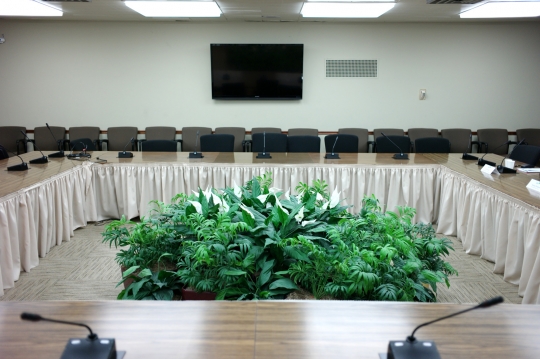
This was the most handsome patch of trapped plants I saw at the State Dept.
David Wood did an excellent job moderating our panel. I was the pipsqueak in a row of heavy-hitters as we compared projects from the block scale of Low2No, up to the entire city of Songdo, South Korea, and then infrastructure efforts of CDG in Morocco. The core of the conversation was summed up well in a comment from a South American government official who will remain nameless, as relayed by fellow panelist Stewart Sarkozy-Banoczy: I can find money to build housing, but how to I deliver all the other aspects that make a thriving community? The traditional capital investment is one thing, but finding the ability to invest in the broader ecosystem of factors that contribute to the ultimate sustainability—or not—of a community is now the challenge.
The approach we're taking with Low2No is to consider the building as situated within a larger spectrum of activities that range from the dark matter work of lobbying for (and co-authoring) new codes & regulations, exploring finacing and operational models, developing programmes to spur low-carbon entrepreneurship and citizenship, and so forth. Coming on almost 4 years into the Low2No experience, we have a pretty solid idea of how to comission and design sustainable urban environments in this interconnected way. Delivery is another slog unto itself, but one that we're happy to be in the middle of at the moment.
It was a solid event that covered a lot of ground, often times deep in the nitty-gritty of finance where I struggled to keep up (my favorite kind). Because I know that the internet loves lists, and I'm not one to disappoint, the messages I kept hearing at the event were:
- Systemic from the start: initiatives should not be done in an ad-hoc way to get them off the ground and then redesigned for scale later. The up-front strategic work should take into account the possibility/mandate of scale from the very beginning and use this as an advantage. In my own words, I would articulate this as "design every platform as a product and every product as a platform"
- Data drives the market: there are still big opportunities for anyone who can provide data (or other comparative mechanisms) that simplifies the task of comparing a variety of options, be it which charity to give money toor which ship to hire for your intercontinental logistics, etc. Jagir Shah gave one potent example: the Carbon War Room began publishing fuel efficiecency data for ships. The availability of this data natrually fed into the exsting data-crunching machines of insurance adjusters and other analysts, effectively raising the price of fuel-inefficient ships. In other words, data doesn't have to be extensive, but it should be operative and useful for the right decisions.
- Collaboration is still hard: building up enough trust to do things differently, to invest in social impact, for example, still takes time. It was encouraging to see many of the world's large banks at the forum to have that kind of scale in the room, but more than anything their participation and movement towards adding social impact products to their suite of offerings is an important act of signaling to the market culture. As we are all making tactical efforts to deliver projects and make deals, we should also acknowledge head-on the broader cultural shifts in risk and trust, and the way that our various cultures of decision-making model these. Multi-disciplinary teams are able to internalize—and appropriately respond to—some degree of these different cultures, giving them a leg up.
- Reality is still messy: contexts change and plans change. An organization's ability to cope with change (both fast and slow) is still what determines its success. Particularly in the case of systemic change, where the full extent of needs and opportunities are in continual evolution (see point #1!), bouncing between the messy details of specific situations and the smooth abstraction of the 30k view is a useful practice, particularly when the problem at hand is without precedent.
- We still need first movers: Anyone who has watched as a potential match funded grant goes unmatched and unfunded knows how painful it can be to have the promise of funding but still come up empty handed. Right now is a similar moment. there's a developing interest in social impact investments, but strident first movers are still needed. As the investment community (and organizations like Sitra!) are able to better evaluate (see points #1&2) and build relationships with (points #3&4) social impact organizations/projects we will see the sector flourish. Who's ready to take the first leap?
A week spent looking inwards and outwards. Lots of work with Sitra colleagues last week - across public affairs and communications; talking to the business development team; moving forward with our workplace renovations and working styles etc. And then plenty of work around Brickstarter and food projects.
Team round-up; we have two people Stateside at the moment; as well as Justin in Boston, we have Bryan in NYC and California. He's talking to all kinds of people around Brickstarter-like projects and HDL2012. Judging by a quick Skype earlier today, he's getting into good discussions; for example, his interview with the folks behind +pool, the technology behind a proposed floating swimming pool in the Hudson, funded via Kickstarter.
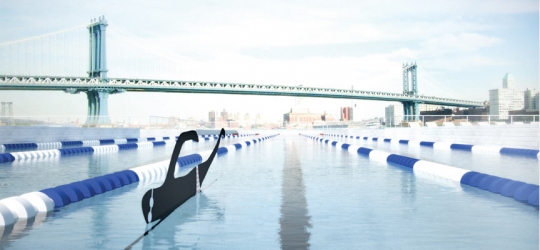
+pool vision. Source: pluspool.org
Marco and the rest of us are now devoting a significant amount ot time to planning HDL2012. More on this when we can, obviously.
Bryan, Kali (aka our colleague Karoliina Auvinen) and I are off to Berlin in a couple of weeks, on Brickstarter research. We're going to chat with Dieter Genske, who I had talk at Arup Melbourne last year, as we're particularly interested in small-scale community-owned energy infrastructure. But we'd also be interested in suggestions as to who else we should talk to while we're there (the background to Brickstarter is here and here; any relevant projects or people we should see in Berlin? Let us know via the comment box below, or tweet via @hdl2010)

Any mention of Berlin necessitates a still from Wings of Desire
Also, a new arrival! Our newest intern Kalle Freese started last week. Kalle's a student at the University of Helsinki, and also one of the best baristas in the Nordic Region, contributing to several of the best local food culture (and of course coffee culture) blogs, as well as working the local Helsinki scene.
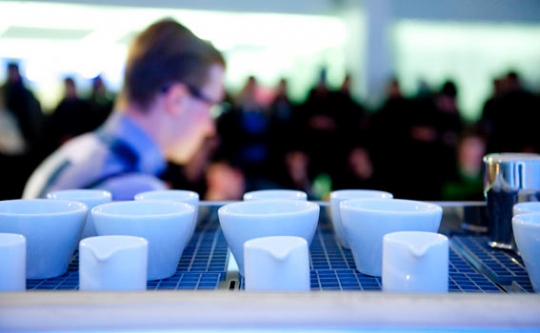
Kalle Freese. Source: nordiccoffeeculture.com
We'll get him to introduce himself here shortly, but you could read his bio at Nordic Coffee Culture in the meantime. While you're there, have a read of Kalle's write-up of his experience in the Finnish barista championships. What's good is the wider sense of how to talk about 'qualities', as well as the broader ideas of practice, service, environment, experience design, and so on.
Kalle will be working us on all projects, but primarily on the food work going on at Tukkutori, in Kalasatama. As with many, he understands and enjoys coffee because of an Antipodean experience, in his case New Zealand. It's a place that, I and many others would argue, possesses the world's best coffee culture (and this is nothing to do with my ongoing search for a good #helsinkiflatwhite, which those who follow my twitter account have to endure.)
I caught up with our Design Exchange placement #1, Sara Ikävalko, on Friday morning. She's got some great video footage of sketching sessions with high school students and others, which we'll get online shortly, and has been running workshops with seniors too; she is busy busy busy.
We rounded off the week in fine style with a great visit from Rodrigo Araya of Tironi Asociadios, in Chile. We were talking to Rodrigo for Brickstarter, and I've typed up the notes from the meeting over at the Brickstarter project blog. Rodrigo came highly recommended by my Arup colleague Alejandro Gutierrez.
Accompanied by my colleagues Karo Luoto, Kali Auvinen and Johanna Kirkinen, we spent a few hours picking Rodrigo's brains. Suffice to say, the projects in Constitución and Calama that Tironi are working on (with Alejandro Aravena as well as Gutierrez) are thoroughly inspiring, and exemplary models for citizen participation. Read more at Brickstarter; in terms of decision-making cultures, it's an invaluable case study.
Finally, it feels like Helsinki World Design Capital is beginning to really emerge now, just as the city emerges from winter. The snow has melted, the sun is shining, there's a Demos-fuelled pavilion latent with potential being built around the corner, and there are a slew of events, publications, projects, and happenings occurring now, which we hope will continue into the summer and beyond. One such publciation incldues 'Helsinki: Beyond Dreams' which Bryan contributed a piece to (you can read it here.)

Illustraton from Helsinki Beyond Dreams by Pent Talvet.
"A generation from now, will Helsinki and Tallinn be connected as a twin city filled with local urbane industries: small factories, craft workshops, courtyard cafes and scientific research labs flourishing side by side in the city centre?"
It's a lovely, lyrical piece building on our shared interest in small-scale manufacturing returning to city streets (and in doing so, finally making use of Helsinki's woefully-underused near-perfect courtyards). Incidentally, The Economist newspaper wrote in a very different mode about the same possibilities just this week, in their special report on 'A third industrial revolution'.

Illustration from The Economist's special report on manufacturing.
Finally, this week's how-to. In fact, a few of them. (As people that grew up with 'View source', we love a good how-to.)
The first, from pioneering coding community Rails Girls, is really nice example of a "how-to" for a good event. Top notch legibility.
Secondly, "Start-up tips from the food truck revolution" is more of an intervew than a how-to, formally, but you get to the same place.
Thirdly, the excellent new Neighborland has some great pointers for how to use their service to get things done in your (US-based) community. They seem so straightforward and common-sensical at first glance, but that's because the folks behind Neighborland are smart.
Finally, and probably-not-that-transferably, have a flick through the 'handbook for new employees' from games company Valve [PDF]. In a world of The Starfish and the Spider, these guys are clearly no fans of arachnids.
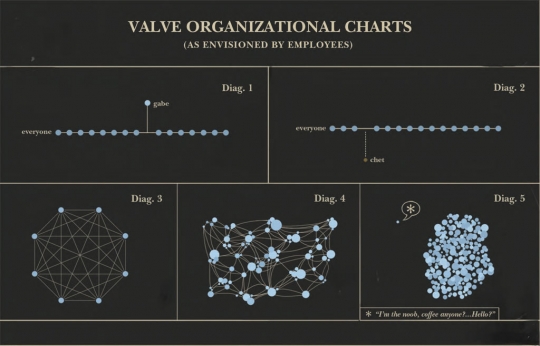
Org charts by Valve employees. Source: Valvesoftware.com
Adam Curtis teaches us to be wary of claims of self-organising communities — quite rightly in my view — but it's often instructive to observe the artefacts of those that try. You might compare and contrast with Forbes earlier this week; turns out there is an 'I' in team after all.
Always with the latenote.
OK, last week was busy. Bryan and I met with the City of Helsinki's Chief Information Officer Markku Raito RE Brickstarter. It was a good, engaged conversation; I'd met Markku in Oslo in December, at the Cisco Public Services Summit (funnily enough, we shared a taxi from the airport into Oslo, purely by chance, before realising we had a few things in common, not least our hometown. This shows there is actually some value to conferences.)
The City is exploring new avenues for citizen engagement in a few different areas, apparently including some variation on the 'local mayors' idea floated in the 'Clues' cards that Bryan et al helped put together.
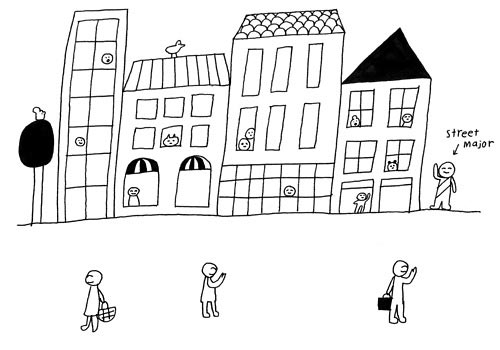
'Street mayor' idea from 'Clues to Open Helsinki'
But the real Mayor, Jussi Pajunen, took to Facebook and Twitter on Monday night to discuss the proposals for a Helsinki branch of the Guggenheim (which I think it's fair to say are 'controversial'). Interesting.
There was also a rather less-considered (in our view) experiment going on , involving people somewhat randomly hammering a touchscreen on a few streets, with little or no context, no comeback or personal responsibility, no attempt to reach a wider population, certainly no deliberation, and no clear idea on what will happen to the votes. Of course, this got significant publicity. Sigh.
(Incidentally, as the Sanomat newspaper points out, this could be third time lucky for the Katajanokka site and has a view on the delaying of the decision-making.)
Back in-house, Marco and I attended one of our internal workshops on Sitra's strategy, focused on the economy. It was good to see a lot of existing work and ongoing conversations on crowdfunding, as part of a 'diversifying sources of funding' discussion within the workshop. The 'Crowdfund' bill going through in the US recently is an interesting development.
More internal work: our plans for our 12th floor renovation - actually prototyping new ways of working, using the renovation of the floor as a lever - are coming to fruition, thanks to sterling work from architects KOKO3. We had a great session with Sitra staff on Thursday, in the traditional weekly get-together of 'torstai pulla' ('Thursday Bun!'). As Bryan noted last week, we've been working on this for a while, and liaising with lots of key people within our organisation, but it was fantastic to see so many Sitra staff actively interested and engaged at this more open session. (And the keener-eyed among you will note why we need to change this floor!)
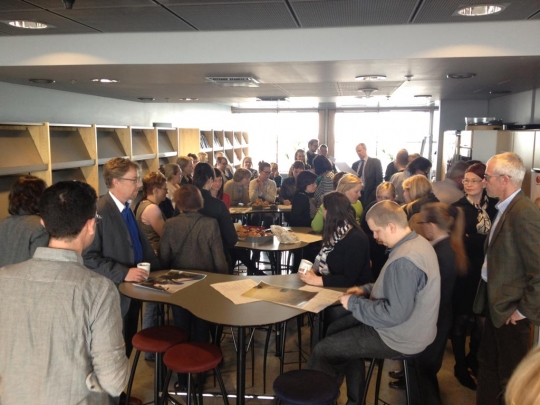
Thursday Bun session discussing plans for 12th floor
The new position in our Design Exchange programme remains open, by the way. Once again, we're looking for a designer to work with Helsinki Department of Social Services for a year (employed by them, working with them, and 'mentored' by us.) It's a great opportunity, so do apply if you're interested.
Speaking of design embedded in public service, this short interview with Head of Design for the UK's Government Digital Services, Ben Terrett, is worth a read too. Their output is shaping up wonderfully, but the broader point about design (and other things) addressing meaningful problems and major challenges, and in doing so making peoples' lives better, is an extremely important side-effect of doing quality work in government.
Thursday, Bryan and I spent the day amidst the slowly de-ruining ruins of Kalasatama - at the Tukkutori market development, specifically - for another all-day workshop continuing the work with Antto Melasniemi, Elina Forss and Ville Relander (noted here previously). All going well, and we're getting close to 'de-cloaking' this project; you can tell that, as we're knee-deep in conversations about the name (ugh).
By the way, I wrote a short piece about street food and urbanism, via Ravintolapäivä, as part of "Manifest", a new magazine put together by Artek and others, for World Design Capital. It's available in Artek stores, across the city, and at the Salone design fair in Milan, which is going on this week. There are Finnish and English editions, and contributions from a good set of writers. (Nice to see my words in Finnish, actually, even though I have no idea if they're the right ones. It's nicely designed by top local firm TSTO too. Well worth picking up if you're in town.) This is part of our ongoing background research around the aforementioned food projects.
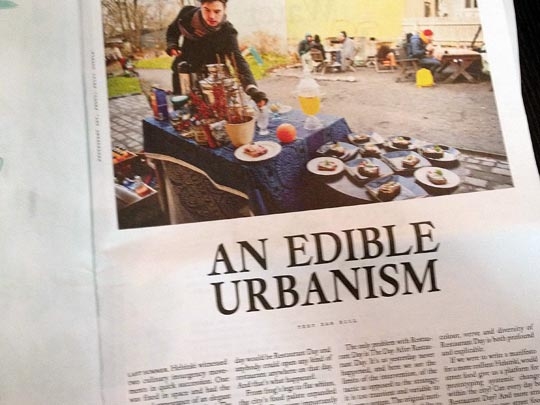
On Friday, I had the pleasure of meeting people from the Strelka Institute for Media, Architecture and Design in Moscow. Strelka is a fantastically interesting intervention into the city - Rem Koolhaas's firm AMO have been involved in the curriculum - and hopefully there's something interesting brewing between us and them.
And we've started getting seriously into planning our next HDL event. It's been a bit of a 'phoney war' up until now, but now we are into dates, venues, formats and participants. Exciting.
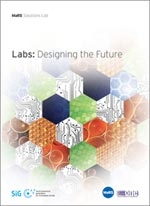
I've also been liaising with Social Innovation Generation and MaRS Discovery District, in Toronto, Ontario, including some interesting exploratory conversations around design labs for social innovation. Lisa Torjman of MaRS wrote an excellent report on the labs concept, drawing from the likes of Mindlab, IDEO, Participle and us. Lisa's report does a great job of setting the scene in particular, as well as expertly nailing the case studies. It's well worth a read. That is an emerging discussion, but heading somewhere very interesting.
We also note with interest John Thackara's extremely useful and thought-provoking set of 'handouts' around particular themes, or challenges. (John's twitter feed is always usefully thought-provoking, too, by the way.)
Finally, and predictably, we've all been drawn in by the second season of DR's majestic political drama 'Borgen'. Such is the way of on-demand media, team members have now each watched an entirely different number of episodes, so any detailed conversations about the plot is verboten (or 'forbudt', perhaps.) Suffice to say, Birgitte Nyborg would ideally be the Statsminister of everywhere.
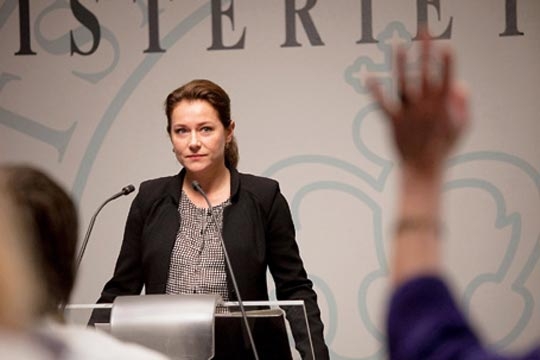
Birgitte Nyborg, Statsminister
Logistics were on the docket this week. Amongst other things, we've been finalizing some hirings that have been in the pipeline for a long while and laying down a bit of structure for the three month run-up to summer. This includes a fair bit of calendaring to make sure that our various travel schedules are well coordinated, especially in light of the new interns joining us and various events in town, such as the DMI conference which Marco is co-chairing.
Are you an aspiring strategic designer looking for a place to apply your talents? This week we officially launched our second Design Exchange placement opportunity with the Helsinki department of Social Services. Apply here if you're interested, and please help us spread the word if you know someone who would be a good fit.
On the subject of interns, Mr. Seungho Lee holds the honor of being the very first HDL intern and he has recently completed a publication entitled Beef Finland 2012 as part of his Masters of Arts coursework at Aalto University. Seungho has focused on constructing a briefing to frame the question of production and consumption of beef in Finland (as you may suspect from the title). We're glad to see that his time with us contributed to his own work and thinking, and the newspaper is a good read.
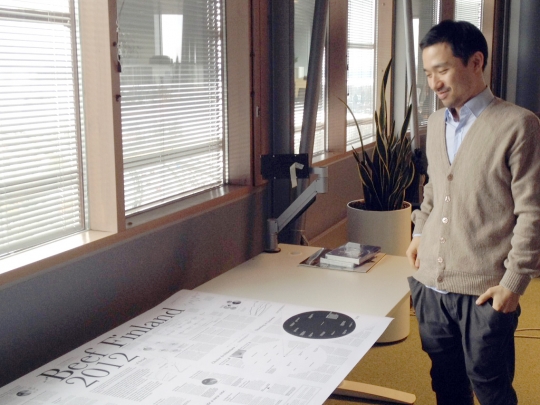
Seungho stopped by to drop off some copies of his thesis newspaper.
Our own focus on food has been a bit dormant this week. Glancing at the revision history of a shared one-pager on our Basecamp site it looks like there have only been a few nibbles since the last workshop. It's to be expected, though, and our next internal workshop on the food work is coming up this week. Workshop one was about putting some brackets around the concept, audience, content, and timeline for the programme we're looking to develop and it ended with a draft one pager. Workshop two will take the one-pager as a starting point and expand it into draft project plan.
We're taking a slightly different tack with Brickstarter. Because of the relatively high pace of global innovation around Brickstarter-like topics at the moment, we've decided to play that project out in public by sharing our research and eventually product development on the blog. Dan and I ended Week 159 by noting some immediate to-dos. Top of the list from a product design perspective: personas and use cases. We also continue to scour the countryside for appropriate NIMBY-potential case studies that we can sketch in code with.
Kali and I met with a gentleman who has been researching wind energy in Finland which was helpful in identifying further avenues for sourcing potential case studies. We also spent some time with Neste Oil in Porvoo, quizzing them about how they interact with the communities who live near their two Finnish refineries and are understandably curious about what's going on with their rather industrial neighbor. On the other end of the scale, we also had a moment to visit a group of designers, artists, and concerned citizens who are developing ideas for Baana, the sunken rail line that Dan wrote about previously.
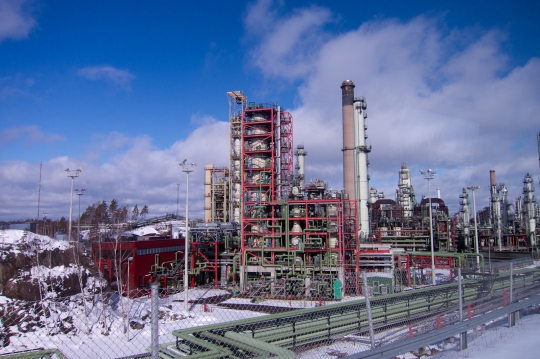
A small corner of Neste's 1300 hectares in Porvoo.

The atelier of a group developing an expanded field of options for the Baana site.
Developing Brickstarter in public is also a way for us to demonstrate what a project-oriented way of working looks, feels, and sounds like as Sitra continues to move towards a new operational model. In that light, we're taking a play from our colleague Karoliina Luoto who managed the development of the newish Sitra.fi website in a very public way via a separate project blog.
As part of our internal development work we've also been coordinating the renovation of one of the floors of the Sitra tower. When it's completed later this year, the new space will give us more project spaces, which we desperately need. And what's a project space, you ask? It starts with a large table and as much whiteboard space as you can muster. Beyond that we're looking for a space which invites ad-hoc meetings, one that communicates a casual professionalism, and one can be flexible with the ebb and flow of work through our organization. We'll dedicate more time to these questions in a future post when there's something more to show!
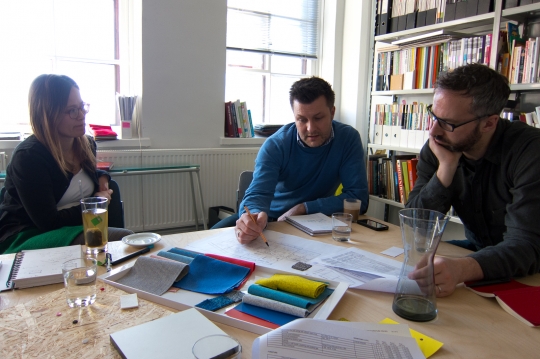
Helka and Jukka from KOKO3 lead us through their proposal for the new floor at Sitra.
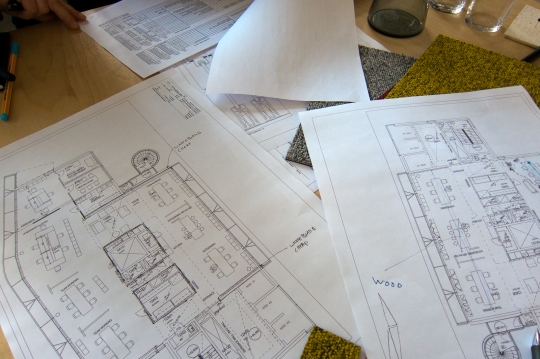
The switch to open floors will be a big step for Sitra, but people have been courageous so far in considering the change.
Technically it was two weeks ago, but since we're on the topic of offices, recently I had the pleasure of visiting Marimekko whose entire operation—design, sales, marketing, production—are housed in one building and have been since the 1960s. Doing so allows them exactly the kind of effects we're seeking to maximize: collaboration, flexibility, and focus.
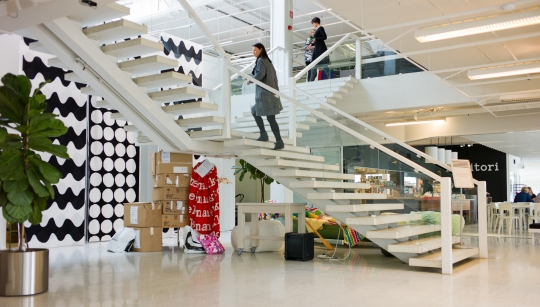
A grand stair in the entrance acts as a collection point for chance encounters as people come and go.
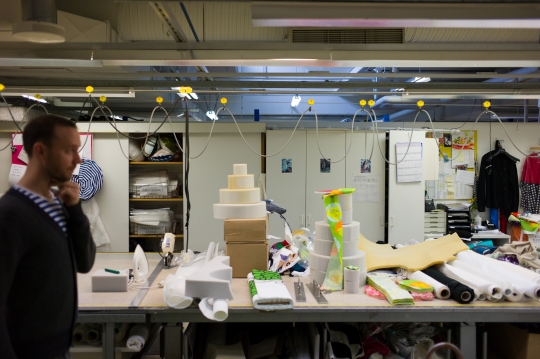
Jeremiah, one of our design leads from the Synergize Finland Studios, was kind enough to give me a tour of the operation.

As you might expect from the Marimekko factory, it's filled with delights.
Embedded in our internal efforts is a transition towards a Sitra culture that is more explicit about what we do, how we do it, and why we do it. With that in mind we enjoyed the ten Design Principles of the UK's Government Digital Service both for its content (many of the same rules apply in the Strategic Design Unit) and its clear and simple presentation.
Today we're also curious, are you as obsessed with Borgen as our whole team has been lately?
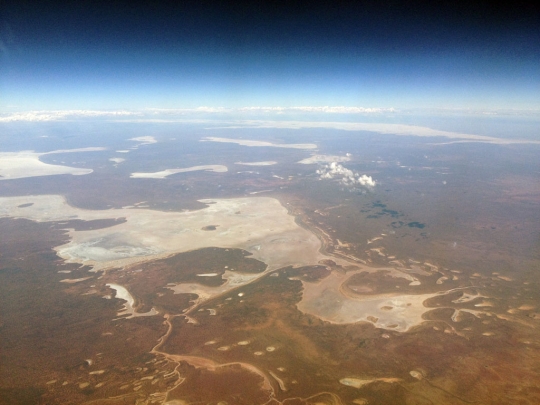
Flying over Lake Eyre, northerly out of Adelaide.
This week, the weeknote is really brought to you by Adelaide and Melbourne Design Lab, rather than Helsinki Design Lab. I've been in Australia all week, and have only the vaguest ideas as to what's been happening back home! Justin's in town, which is good, and he, Marco and Bryan have been knee-deep in our internal organisational strategy work, as well as keeping our Low2No food projects ticking over.
One thing; our Design Exchange operative #1 - Sara, embedded at City of Lahti - has got a new site live for the 'Radanvarsi' urban development around the train station in Lahti. The site is for the project competition, and citizen participation around the development in general. It's all slightly beta - of course - but will begin filling up from now on. (PS. Note, we're looking for another strategic designer in this progreamme, as part of Helsinki Department of Social Services - apply here.)
But as the team were slaving over a hot organisational strategy stove (?!) in a Helsinki which had momentarily turned its back on spring, I was in sunny - very sunny - Adelaide.
I was there for a quarterly meeting of the Integrated Design Commission Advisory Board (more info on the board here). The IDC, led by Commissioner Tim Horton, and part of the office of South Australian Government Architect Ben Hewett, is one of the most interesting design interventions in Australia. It's also one of the few other organisations worldwide also working as a strategic design capacity for core public institutions.
It grew directly from the work of one of Adelaide's Thinkers in Residence, architect Prof Laura Lee, and sits right at the heart of government - part of the Department of Premier and Cabinet. It's charged with aligning design disciplines, industries and efforts across the state. In practice, this means focusing initially on planning, architecture, urban design and other built environment issues - but given the state's manufacturing history, this also means some interesting incursions into industrial design, via prefabricated housing. In this respect, it's a little different to our mission - though we're often covering similar ground. But their work essentially concerns gluing back together core disciplines and perspectives that our societies have allowed to wander too far apart; which is certainly developing a similarly holistic view to that pursued by our Studio process.
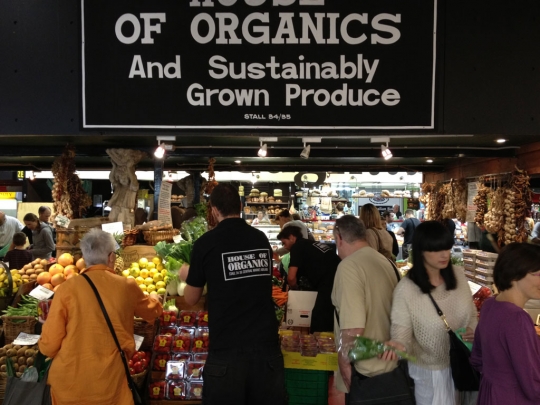
Adelaide's excellent Central Market indicates the value of local, organic everyday food.
(Tim and I often reflect on the ideal proxmity from seat of power, for a strategic design function. You need to be close to effect genuine change, clearly, but not too close as to be a political football. The IDC team seem to have it about right; see also Ben's work as Government Architect, and the major announcement of a City Design Review Panel, which was happening last week; a huge step forward to get qualitative assessment at all stages of the urban development process. As Planning Minister John Rau said of the announcement "If we are going to encourage more South Australians to live in the city, then excellent design is critical.")
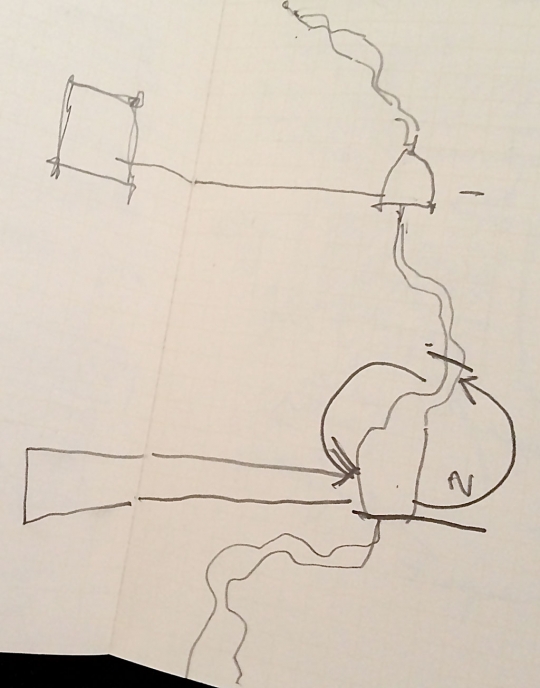
Tim Horton's sketch of River Torrens system, scribbled in my notebook over lunch
Amongst other projects, the IDC team are at the heart of the 5000+ project, which is intended to be a replicable model for citizen participation in urban planning, or more broadly, discussions as to what Adelaide is for. This is particularly interesting as regards Brickstarter and Low2No, but worth checking out in general. IDC have even successfully taken the HDL Studio format into their work - which is exactly what we hope happens by publishing blueprints in such detail - which builds on several conversations we had when I was originally in Australia, pre-Sitra.
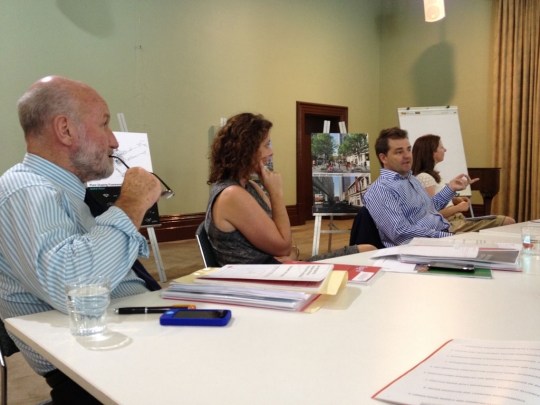
Advisory Board: Prof, Graeme Hugo, Associate Prof. Joanne Cys, Tim Horton, Jane Crosby
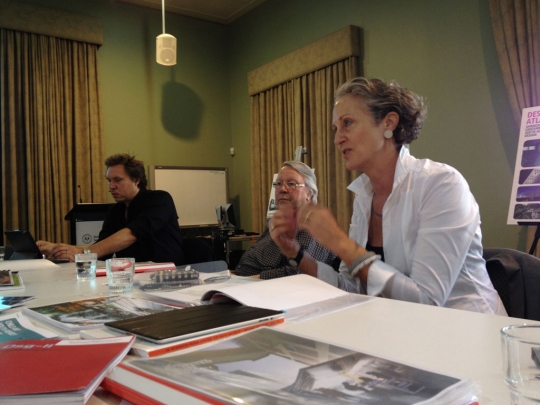
Advisory Board: Ben Hewett, John Denton, Dr Elizabeth Farrelly
I think Adelaide is a great little city, as it happens ("little" in comparison to Sydney and Melbourne, both of whom tend to look down their noses at it, as is the way of such things. Adelaide, like Helsinki, is a good population size for a city; it's the distribution that needs a little work.)
Like most Australian cities, it's slowly beginning to develop a sense of its own urbanity, despite a good half-century of suburb-dominated misteps, and that is good to see. The work of the IDC, and the several other initiatives in the city, will be key to ensuring a vibrant and productive urbanism emerges. It was great to see evidence of 'emergent' innovation filling the numerous gaps left over by 20th century urban policies, such as this fabulous pop-up lobster taco stall and winery, occupying a vacant parking lot. From totally dead gravelled non-space to fine lobster tacos and some of the world's best wine, and 'one-in-one-out' by 7pm on a warm Friday night. (Please excuse the dark mobile phone video, but it captures something of the mood.)
One paper the IDC delivered to the board was SGS Economics' review of the economic impact of the Renew Newcastle intiative, revealing an extraordinary 10:1 multiplier effect of Renew Newcastle, as well as other 'shared value returns' on investment. (Though when assessing these 'economic impact of cultural initiative' papers, I'm always reminded of my friend Justin O'Connor's note that no-one ever asks for a 'cultural impact of economics' study, which would surely reveal the opposite of a multipler; a divider, even?).
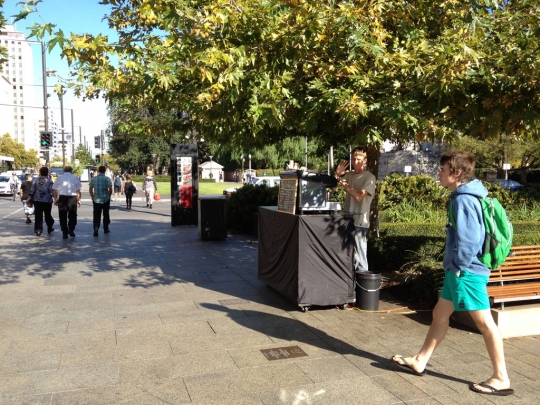
Pop-up coffee stall, part of a trial testing looser regulatory approaches to licensing in the city.
And before our meeting in Adelaide, I caught up with Marcus Westbury in Melbourne. Marcus created the Renew initiative - first in Newcastle, NSW - and Renew Australia is now based in a good retrofit of an industrial unit in Brunswick, Melbourne. It was great to catch up with Marcus; he and I worked together on The Edge in Brisbane, and he's such an original thinker (and doer) in terms of genuinely shaping cities. Notes to follow on that chat over on our Brickstarter project site. (There's a Renew Adelaide, as it happens.)
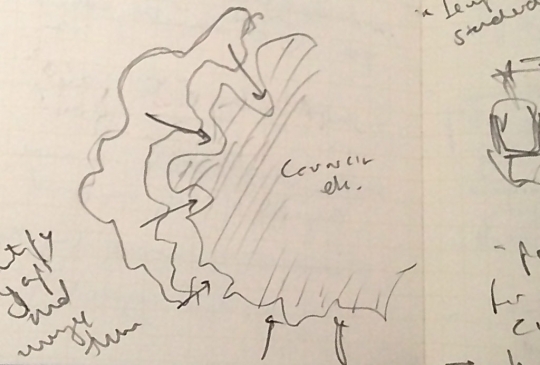
My diagram of Renew Newcastle looking for gaps in 'dark matter', during chat with Marcus Westbury
I was in Melbourne for a crazy 36 hours courtesy of the University of Melbourne School of Design, and particularly the architecture department. I met some very bright urban design masters students for lunch, gave a public lecture (thanks to all who turned up; Twitter was pretty effective at getting a few hundred in a room with not much notice.) Ditto a lecture at Arup Melbourne the following lunchtime, part of the Innovation Forum series now curated by Stuart Candy.
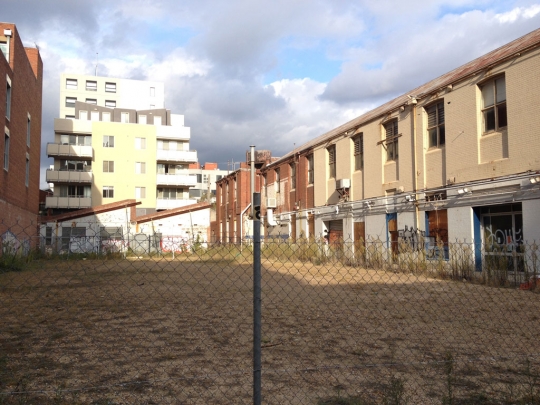
Brickstarter-friendly site, 500m south of University of Melbourne architecture department.
Back to Adelaide, and meetings with TACSI's Brenton Caffin, around where might 5000+ go next, and IDC again, advising on how to handle discussion around smart city strategies, before an incredibly useful phone conversation with City of Sydney about their exemplary recent tender for food trucks.
It was great to hear about their approach, which Helsinki - and many other cities, for that matter - can learn much from. We're trying to broaden the conversation around street food here in Helsinki - including with the City, as previously noted - and these kind of case studies from other cities are often very important in terms of shaping opinions. Again, more details soon, as this one warrants a post of its own over at Low2No.
Week 157, and a touch of 158 if we're being honest, was mostly about getting things out the door. Almost by coincidence, we finally launched new websites for the Design Exchange Programme and Brickstarter, made some cosmetic tweaks to this very website, and published a 98 page book on street food in Helsinki. It was a lot, but a long time coming!
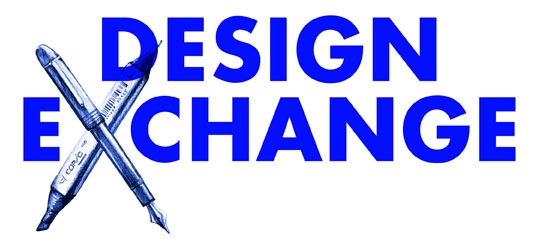
The Design Exchange (DEP) website is where you can track the progress of our embedded designers. The goal of the DEP is to move one step closer to policy by design. This entails enhancing the capabilities of the public sector: new abilities to frame problems, iterate solutions, seek feedback, and communicate clearly.
There's a quick intro to the programme and I've also shared a bit of the background of how the DEP came to be. When I look through our files on that topic, they stretch back to late July 2010. Although we had discussed it internally as a 'what-if', the concept first appeared in the Clues cards (especially the one about Tailor Made Municipal Services) and came up again during the Ageing Studio discussions.
Perhaps it's no surprise that Petri Lehto, a member of the Ageing Studio, has been one of the driving forces behind bringing the DEP to life and we're grateful for his collaboration, as well as that of the many other people involved at our partner organizations.
At the moment we have only one placement up and running, with Sara Ikävalko working at the city of Lahti to develop a new participatory process for a competition they are hosting there.
We're getting closer to having more placement opportunities open. When that happens we'll advertise them here on the HDL site as well as the Design Exchange site, so be sure to check back if you're a Finnish-speaking designer interested in working in the public sector.
In a nice twist of symmetrical history, the same week that we launch a project which took cues and clues from friends at MindLab, saw another group, the MaRS Discovery District in Toronto, looking to HDL for advice on their own explorations of a new lab. The report is quite informative, and we're happy to be a reference as they look for the best way to put "complexity, networked collaboration and design" to good use.
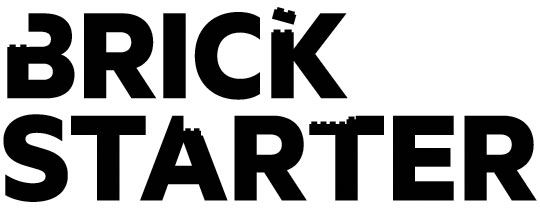
Next up was Brickstarter, a project we're developing that seeks ways to turn NIMBY into YIMBY (yes in my backyard). How might we reorient community action from no full-stop to "no, but how about..." or even "I'd really like...!"
As Dan explains in the introductory blog post, our thinking and work on Brickstarter is beginning to pick up, so we needed a place to bind these thoughts together into a big ball of ideas. The Brickstarter blog is a mix of notes from our field trips, quick dives into terms and concepts, and eventually some case study research. Some themes:
Community decision-making; new engagement tools; long-term investment in sustainable infrastructure; participation and representation; prototyping as research, iteration as planning; user-centred redesign of governance and legislation; different relationships between citizens, businesses and governance; potentially even prototypes of political systems...
To give you a concrete example, What's different about this shady courtyard on Tarkk'ampujankatu...
And this one on Tehtaankatu...?
It's hard to see with the trees full of life in the summer, but the biggest difference between these two courtyards is that features a garden and the other a parking lot. Otherwise they're about the same size, in the same neighborhood, and have the same solar orientation. They're essetially the same from a contextual point of view, yet one group of owners has decided to use the space for parking and another for a garden.
With Brickstarter we are trying to understand how these decisions get made, and eventually to developing a platform that enables them to be made with greater levels of participation. Why? Because we think that new tools will allow communities to make decisions like this with higher social equity, in a less devisive manner than typical NIMBY dynamics, and with heightened attention to opportunities that consider the long-term.
Recently there has been an uptick of interest in 'meanwhile' or temporary usage of sites. We see this as positive development, and in a certain way Brickstarter is our attempt to look at how the verve of these grassroots efforts can be grafted onto the institutions that shape everyday life. One of our hypotheses at the moment is that there is a missing interface to government. What would that look like? Figuring it out will require our usual dip into strategy, but it’s likely to also involve building product(s).
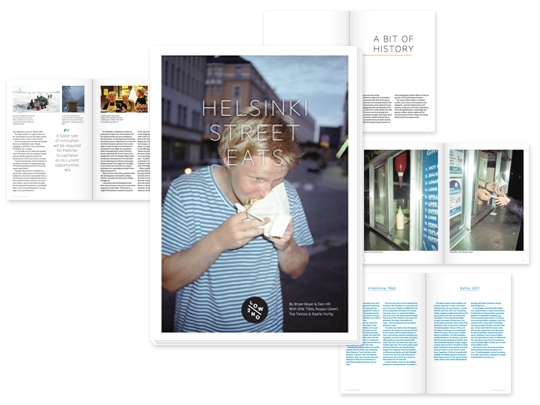
Helsinki Street Eats, the book which was our third release this week, has similar ambitions. We wrote the book to begin asking questions about the extremely positive developments of Ravintolapäivä and the Camionette. On it’s own a festival like Ravintolapäivä is a nice urban experience that happens a few days a year, but the next morning it's gone without a trace. With a bit of work on the dark matter, these experiments can be looked at anew as prototypes of a future regulatory, business, and social context.
The book was a way to crack open that question, and now we’re slowly but surely sketching out a way for those ideas to take root. If you’re the type who is into books and publications, I wrote a post about the ways we experimented with print-on-demand in the production of Helsinki Street Eats.
Otherwise there’s not much to say beyond get your copy here!
Beyond these launches, we're still working on internal projects. Parts of that effort is about to wind up soon, which is good because we have our hands full at the moment—as you can probably tell!
That pile of snow from last week? Still there. And not only that, it's snowing as I type, so the thing is growing.
Dan remarked the other day that during this time of year it feels like everyone is booting up new projects. Could the surge be detected in the number of domain name registrations? We've booked one this week, with another to come once we settle on a name for it. Buying a domain name is a good inflection point. It means the project has solidified enough to be developed in public.
They come and they go. The domain name for a quick project from a couple years ago will be expiring soon, so we've moved it to this website for posterity. The permanent home for our Clues to Open Helsinki is now in the HDL dossiers. The grunt work of moving the project from one website to another was a nice opportunity to revisit the work and be reminded of the extent to which many of our current interests were there in nascent form. Food? Check. Community decision making? Yup. Design exchange? Sure enough!
During the last couple months we have been slowly building up two projects about food and community decision making, and this week they took the leap from more or less fuzzy interest areas to specific proposals. We forced ourselves to sit down and draft a one page description for each project.
Despite the awkward term—and please let us know if you have something better—we like one pagers around here because they are a simple way to bring a level of rigor in one's thinking: big ideas, small page. Here's how we do it.
Working simultaneously in Google Docs or huddled around a Word document on a laptop, we take turns drafting sentences, phrases, and fragments. At an early stage the one pager is mostly about why and what, and the who, how, and when to be covered by a cursory sentence. Or left out for the moment.
It's hard to resist the urge to drop the document into InDesign and start fiddling with layouts and font sizes to make room for more words on the page, but point of writing the one pager is to work within rigid boundaries and take advantage of the fact that the format forces you to make tough decisions. To really test yourself, try using a bullet list or two. If you're as allergic to corporate speak as I am, this will be a true test of your mettle.
But bullet points were invented for a reason: done right, they should be distilled versions of your main points. In our case, it's also part of writing to our audience. The kind of people who we need to read our one pagers tend to be used to, even expect to see, bullet points in the documents that glide across their desk. Dan calls this method designing, which is a tactic that all of us on the team practice innately.
By the end of HDL Global 2010 we had drafted something like 39 different versions of the one page description that went out to everyone from invitees to press people. Those all grew out of a single document, so the process left us with a family tree of explanation.
With luck, the two single page documents that we drafted this week will grow similar trees as they develop. Here's the first couple paragraphs of the current draft of our document for 'Brickstarter', a project about community decision making:
Brickstarter is a 21st century social service. It enables everyday people, using everyday technology and culture, to articulate and progress sustainable ideas about their community. Brickstarter is a platform to turn possibilities into proposals into projects.
The interface between citizens and institutions can be slow, awkward and cumbersome. For years, this was just the way things were. Yet the tools and media that people now use to orchestrate their everyday lives rapidly outstrip those used by most municipalities, ministries, and other institutions.
Brickstarter takes advantage of social media and mobile apps in order to address this disconnect, by developing a more articulate, more responsive, and more representative platform for citizens and institutions to work together.
What's missing here is an articulation of how Brickstarter connects community matters to dark matter but, you see, that's in a bullet list further down the page.
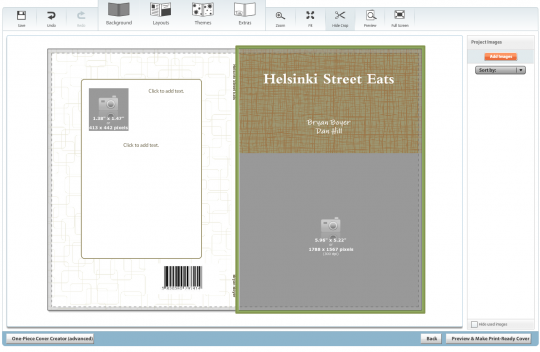
Never trust a website to design your book cover
Yes, the food booklet is still coming. In fact, that should be available for download by tomorrow. The Print on Demand Service tried to design a cover for us, but we've decided to go a different direction.
The good part of friday was spent in Kalasatama in a workshop about food entrepreurship. The session culminated in three, at at times four, people around a laptop drafting the one page description of the project that we spent the day sketching out. It's trending in the right direction and now we need to work quickly to ensure that we can meet an ambitious timeline.
Sitra has been active on food topics for a while now, most recently by supporting the development of the wholesale market with an eye towards local and organic products. That was work on the 'platform', and our upcoming efforts will be building an 'application' to take advantage of that platform.

The centerpiece of the wholesale market is Kellohalli, an old butchery facility that is named for the clock on its facade. In a few months this space will be cleaned up and open to the public.
To close, an interview with Jonathan Ive in the London Evening Standard. He describes himself as "interested in being wrong." I think I like those words more than the things he and his team produce. The interview is full of good stuff, including this:
We struggle with the right words to describe the design process at Apple, but it is very much about designing and prototyping and making. When you separate those, I think the final result suffers. If something is going to be better, it is new, and if it’s new you are confronting problems and challenges you don’t have references for. To solve and address those requires a remarkable focus. There’s a sense of being inquisitive and optimistic, and you don’t see those in combination very often.
